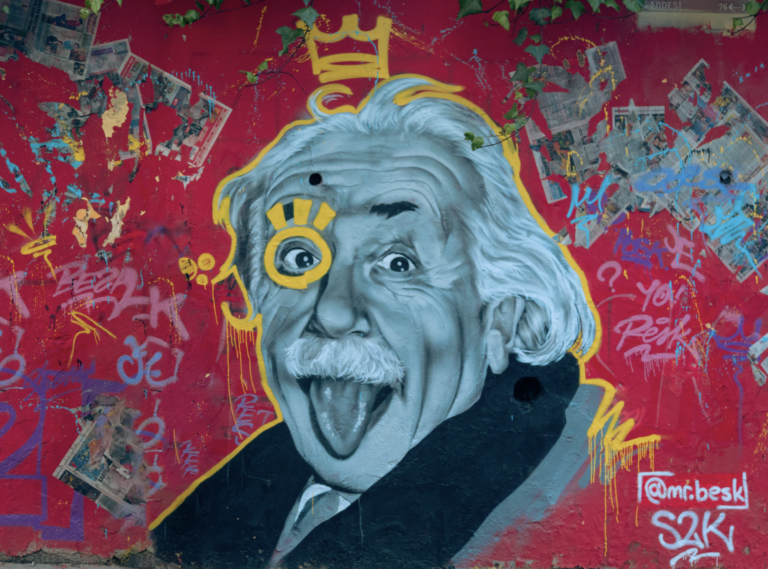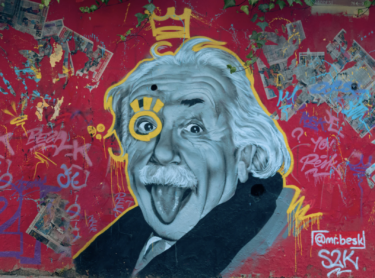はじめに
サイエンスの動画を見ていたら数学のジャンルがあり、アルベルト・アインシュタインの動画があった。ちょっと面白そうだと思ったので、試聴してみた。5分ほどの短い動画に非常にうまくまとめている。さすがだ。
(出典:YouTube)
アインシュタインの功績
アルベルト・アインシュタイン(1879年3月から1955年4月)は、20世紀最高の物理学者と呼ばれる。その代表的な功績は、特殊相対性理論および一般相対性理論であり、相対性宇宙論であり、ブラウン運動の起源を説明する揺動散逸定理であり、光量子仮説による光の粒子と波動の二重性である。これ以外にも、アインシュタインの固体比熱理論、零点エネルギー、半古典型のシュレディンガー方程式、ボーズ=アインシュタイン凝縮などを提唱した。1905年にアインシュタインは特殊相対性理論に到達し、博士論文にまとめるがそれを理解できる人がいないために、ブラウン運動に切り替えて博士号を取得したという。欠点もあるけど素晴らしい天才。それがアインシュタインであり、アインシュタインの魅力だと思う。
アインシュタインが1905年に発表した4つの論文
3月:光は波であり、同時に粒子(Particle)である。
5月:目に見えない原子の存在をブラウン運動で証明した。
6月:光の速度はどのような状態でも一定という特殊相対性理論を定式化した。
9月:特殊相対性理論に続く「ついで」として、質量とエネルギーの関係式を示した(E=mc^2)
ドリルの8つの質問
Q1) Einstein’s first “miracle year” paper, in March 1905, put forth a surprising idea. He proposed that:
光はそれまで波と考えられていたが、アインシュタインは波動と粒子の二重性を示した。これは画期的な考え方だった。
Q2) Einstein’s second “miracle year” paper, in May 1905, showed that _____ could explain the so-called “Brownian motion” behavior of small particles randomly moving around in a liquid.
目に見えないアトム(原子)の動きをブラウン運動に基づいて証明するというのは秀逸だ。
Q3) Einstein’s third “miracle year” paper, in June 1905, introduced his special theory of relativity. The key concept of relativity is that:
アインシュタインは、自由な好風のアーラウの学校の丘で寝転がりながら空を見ていて、「自分が光の速さで光を追いかける」という不可思議な夢を見たという。それがきっかけとなり、光の速度は一定という真理に辿り着き、特殊相対性理論を書き上げた。神掛かっているとしか思えない。
Q4) Einstein’s fourth “miracle year” paper, in September 1905, expanded on the results of the relativity paper and thereby concluded that:
質量は個体、エネルギーは気体と思われていたが、実は同等(equivalent)であるとアインシュタインは考えた。具体的には、あの有名なE=mc^2だ。非常にシンプルだけど美しい。どのようにしてこの公式を導いたのだろう。こんな式を自分も導きたいと思う。
Q5) Surprisingly, Einstein’s miracle year did not make him famous. That only happened later when:
奇跡の1905年に正規の発明となる重要論文を4つも提出しながらもアインシュタインは注目を集めることはなかった。しかし、事態が急変したのは、1919年に日食中(solar eclipse)の星明かりの屈折が測定され、一般相対性理論が確認されてから注目されるようになった。
Q6) Of Einstein’s four “miracle year” papers, which do you find most interesting and why? Which topic would you like to learn more about?
どの論文に特に興味があるかという質問。答えは人によって違いけど、自分はエネルギーと質量の関係を数式化した論文がシンプルで美しいので、最高にすごいと思う。
Q7) After you view this lesson, how did your perception of Einstein change or stay the same?
もっとアインシュタインについて知りたいし、学びたいと思った。
Q8 Quotations attributed to Einstein appear all over the place. Though a good number is actually fake, he did have a way with words and left us with many pithy and profound sayings.
成功を目指すのではなく、いつも何か問題や課題を考えていること。スマートな人間よりも価値のある人間を目指すこと。そんな名言が好きだ。
まとめ
平和主義のアインシュタインが結果的に原子爆弾の開発の提唱者となったのは皮肉だし、本人も忸怩たる思いだったろう。ニュートンが微分積分学や光学のプリズム、そして万有引力の法則の元になる考えを深めたのが、ペストの大流行で大学が休みになり、故郷で過ごした18ヶ月の功績であると聞いたことがある。アインシュタインもまた奇跡の26歳の3月から9月の実質半年に集中していた。素晴らしい。
以上
最後まで読んで頂きありがとうございました。
拝
参考:英語のスクリプト
1905 Einstein`s Miracle Year
As 1905 dawned, the soon-to-be 26-year-old Albert Einstein faced life as a failed academic.
Most physicists of the time would have scoffed at the idea that this minor civil servant could have much to contribute to science. Yet within the following year, Einstein would publish not one, not two, not three, but four extraordinary papers, each on a different topic, that were destined to radically transform our understanding of the universe.
The myth that Einstein had failed math is just that. He had mastered calculus on his own by the age of 15 and done well at both his Munich secondary school and at the Swiss Polytechnic, where he studied for math and physics teaching diploma. But skipping classes to spend more time in the lab and neglecting to show proper deference to his professors had derailed his intended career path. Passed over even for a lab assistant position, he had to settle for a job at the Swiss patent office, obtained with the help of a friend`s father. Working six days a week as a patent clerk, Einstein still managed to make some time for physics, discussing the latest work with a few close friends, and publishing a couple of minor papers.
It came as a major surprise when in March 1905 he submitted a paper with a shocking hypothesis. Despite decades of evidence that light was a wave, Einstein proposed that it could, in fact, be a particle, showing that mysterious phenomena, such as the photoelectric effect, could be explained by his hypothesis. The idea was derided for years to come, but Einstein was simply twenty years ahead of his time. Wave-particle duality was slated to become a cornerstone of the quantum revolution.
Two months later in May, Einstein submitted a second paper, this time tackling the centuries-old question of whether atoms actually exist. Though certain theories were built on the idea of invisible atoms, some prominent scientists still believed them to be useful fiction, rather than actual physical objects. But Einstein used an ingenious argument, showing that the behavior of small particles randomly moving around in a liquid, known as Brownian motion, could be precisely predicted by the collisions of millions of invisible atoms. Experiments soon confirmed Einstein’s model, and atomic skeptics threw in the towel.
The third paper came in June. For a long time, Einstein had been troubled by an inconsistency between two fundamental principles of physics. The well-established principle of relativity, going all the way back to Galileo, stated that absolute motion could not be defined. Yet electromagnetic theory, also well established, asserted that absolute motion did exist. The discrepancy, and his inability to resolve it, left Einstein in what he described as a state of psychic tension. But one day in May, after he had mulled over the puzzle with his friend Michele Besso, the clouds parted. Einstein realized that the contradiction could be resolved if it was the speed of light that remained constant, regardless of the reference frame, while both time and space were relative to the observer. It took Einstein only a few weeks to work out the details and formulate what came to be known as special relativity. The theory not only shattered our previous understanding of reality but would also pave the way for technologies, ranging from particle accelerators to the global positioning system.
One might think that this was enough, but in September, a fourth paper arrived as a “by the way” follow-up to the special relativity paper. Einstein had thought a little bit more about his theory and realized it also implied that mass and energy, one apparently solid and the other supposedly ethereal, were actually equivalent. And their relationship could be expressed in what was to become the most famous and consequential equation in history: E=mc^2.
Einstein would not become a world-famous icon for nearly another fifteen years. It was only after his later general theory of relativity was confirmed in 1919 by measuring the bending of starlight during a solar eclipse that the press would turn him into a celebrity. But even if he had disappeared back into the patent office and accomplished nothing else after 1905, those four papers of his miracle year would have remained the gold standard of startling unexpected genius.




